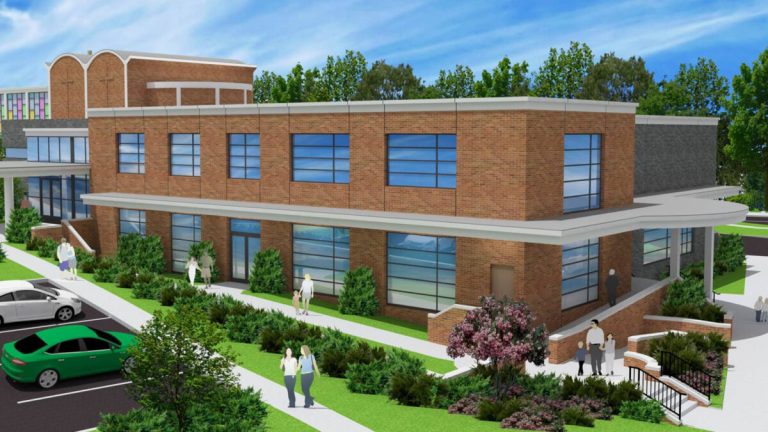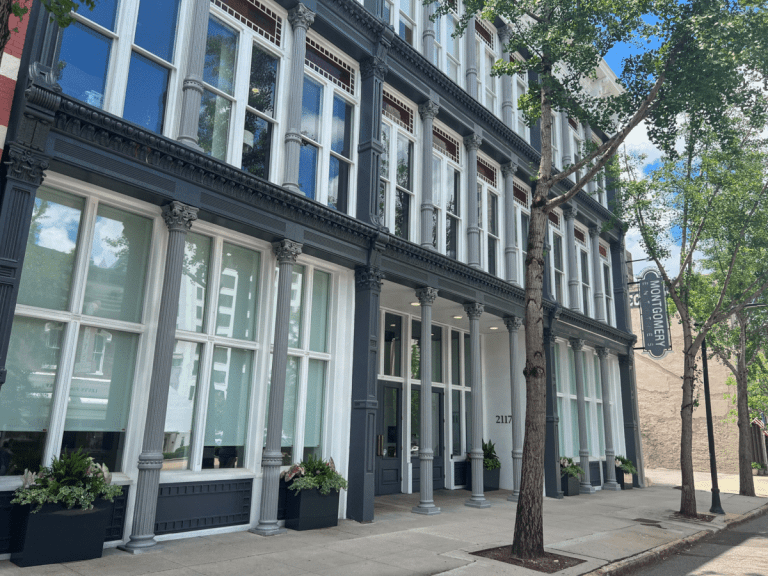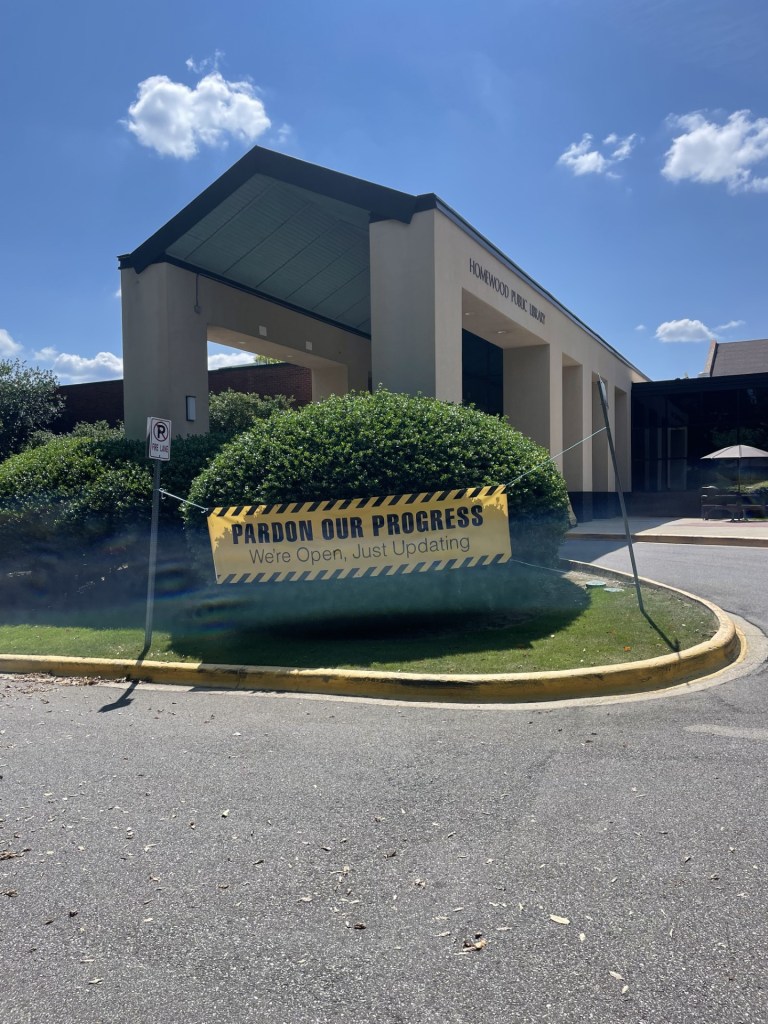Birmingham’s historic Greyhound Station is being redeveloped for the future today [PHOTOS]
Reading time: 7 minutes
Sponsored
![Birmingham’s historic Greyhound Station is being redeveloped for the future today [PHOTOS] 1 Architects, developers and a designer on the old Greyhound station in Birmingham](https://i0.wp.com/bhamnow.com/wp-content/uploads/2020/10/wblead.jpg?resize=1200%2C628&quality=89&ssl=1)
For years, Birmingham’s historic Greyhound station has been what architects call a “dormant opportunity.” That’s about to change—thanks to developer Mike Mouron and Williams Blackstock Architects. Keep reading for the inside scoop on this incredible renovation project featuring historic preservation and adaptive reuse, plus original photos.
A little background on Birmingham’s Historic Greyhound Bus Station
![Birmingham’s historic Greyhound Station is being redeveloped for the future today [PHOTOS] 2 image of the old Greyhound station in Birmingham](https://i0.wp.com/bhamnow.com/wp-content/uploads/2020/10/Slide14.jpg?resize=1280%2C720&quality=89&ssl=1)
Located at 618 19th Street North, the historic Greyhound Bus Station is a block away from Alabama School of Fine Arts (ASFA), Linn Park and City Hall.
Brittany Foley is the lead architect on this project. She said the “streamlined moderne” design of the Greyhound Station was completed before WWII.
Due to war-related supply shortages, they had to wait ’till 1950 to complete construction. Once it was done, people said it was one of the largest bus stations in the Southeast.
The Greyhound Station remained a functional bus station for almost 70 years.
Birmingham’s Greyhound Station becomes part of history
![Birmingham’s historic Greyhound Station is being redeveloped for the future today [PHOTOS] 3 Freedom Riders at the old Greyhound Station](https://i0.wp.com/bhamnow.com/wp-content/uploads/2020/10/Slide19.jpg?resize=1280%2C720&quality=89&ssl=1)
The station became part of history in 1961 when a group of Freedom Riders—aiming to end segregation on interstate transportation—came to Birmingham.
The first Riders were brutally beaten at the Trailways Station (the other bus station in town at the time).
Undaunted, organizer Diane Nash sent more Riders to Birmingham.
“When they arrived…at the Greyhound Bus Station, Eugene ‘Bull’ Connor ordered police to arrest and jail them, including John Lewis. Saying he could not stand hearing them sing their freedom songs anymore, Connor himself drove them to the Alabama-Tennessee state line and ordered them not to return.
But they did return. With the help of Rev. Fred L. Shuttlesworth, they continued their Greyhound bus ride from Birmingham to Montgomery, where an angry mob attacked them. Eventually, the Freedom Rides led to federal laws ending all racial segregation of public facilities involving state-to-state travel.”
Civil Rights Trail plaque in front of the old Greyhound Station building
In the 1970s, the station had its first big renovation. It stayed in use until 2017, when Birmingham’s bus operations moved to the new Intermodal Station.
Since then, the old Greyhound Station has been a lonely shell of its former self. Until now.
The building is going to be incredible
![Birmingham’s historic Greyhound Station is being redeveloped for the future today [PHOTOS] 4 rendering for the redone Greyhound Station](https://i0.wp.com/bhamnow.com/wp-content/uploads/2020/10/ghrendering.jpg?resize=1500%2C959&quality=89&ssl=1)
Who’s behind the redo: Mike Mouron + Williams Blackstock Architects
![Birmingham’s historic Greyhound Station is being redeveloped for the future today [PHOTOS] 5 Architects, designer and developers on the old Greyhound station in Birmingham](https://i0.wp.com/bhamnow.com/wp-content/uploads/2020/10/William-Blackstock-Greyhound-Station-2.jpg?resize=1500%2C1000&quality=89&ssl=1)
Mike Mouron has been in the development business since 1990. After he retired from running his nationally-focused companies in 2012, he shifted his focus to all local projects right here in Birmingham.
In 2019, Mouron bought the old Greyhound station for $2.06 million, with the goal of restoring it to its former glory.
![Birmingham’s historic Greyhound Station is being redeveloped for the future today [PHOTOS] 6 Brittany Foley of Williams Blackstock Architects](https://i0.wp.com/bhamnow.com/wp-content/uploads/2020/10/Brittany-Foley-COLOR-resume.jpg?resize=450%2C600&quality=89&ssl=1)
He knew exactly who he wanted to help him do the job right. Mouron had worked with Williams Blackstock Architects on several projects. These include the Federal Reserve Building and 2200 Magnolia.
“I was so very pleased with both of those projects that when I contracted to purchase Greyhound, I immediately went to Williams Blackstock. I like working with Brittany Foley, who’s got a Master of Preservation Studies degree from Tulane.
The architect has to understand the rules of the National Park Service and the Alabama Historical Commission. If they get outside the lines, it proves to be very costly.”
Mike Mouron, developer of the Greyhound building
Who will occupy the redone Greyhound Station?
The goal is to repurpose the space for one office tenant who can use all of it. Or, two tenants could divide the space and keep the historical character of the building.
Currently, the focus is on finishing the core and shell.
According to Mouron, the Greyhound Station offers a whopping total of 27,500 square feet.
Plus, the parking lot has room for 70 vehicles—a rare and valuable commodity for downtown Birmingham.
It’s all in the details—historic preservation + adaptive reuse at Birmingham’s Historic Greyhound Station
![Birmingham’s historic Greyhound Station is being redeveloped for the future today [PHOTOS] 11 streamlined moderne architectural style](https://i0.wp.com/bhamnow.com/wp-content/uploads/2020/10/Slide16.jpg?resize=1280%2C720&quality=89&ssl=1)
Foley explained how the original design of the building—a unique style in Birmingham—celebrated post-WWII advancements in transportation, including:
- Commercialized flights
- Robust highway system
- Commercial trains
Back in the 1970s, the building underwent an extensive renovation which removed a lot of the original architectural style’s characteristic detailing.
When Mouron bought the building, he put together a stellar team:
- himself, with his passion for mission-driven development
- Williams Blackstock, with their passion for revitalizing downtown
- Foley, who specializes in adaptive reuse and historic preservation.
Now, the future of the old station looks bright.
The details tell a story
Architectural features on the outside
Here are some of the special architectural features Williams Blackstock and Mouron are taking care of on the outside of the building:
- Restoring the exterior to the original streamlined moderne aesthetic.
- Turning the outside space (where a large bus canopy used to be) into an outdoor amenity space for office tenants.
- Having two period buses refurbished—these can be used for outdoor conference rooms.
Inside plans
Here’s just some of what they’re doing on the inside:
- Adapting the entire space to echo the mid-century spirit—with a contemporary feel.
- Readapting the indoor spaces for new office use.
- Carefully restoring the inside existing materials where possible, including ceilings, terrazzo flooring and the stairs to the old segregated waiting room.
- Refurbishing the old segregated bathrooms in the basement
- Adding an elevator, updating the building systems and providing contemporary lighting.
![Birmingham’s historic Greyhound Station is being redeveloped for the future today [PHOTOS] 18 the monumental stair at the redone greyhound station in Birmingham](https://i0.wp.com/bhamnow.com/wp-content/uploads/2020/10/Slide79.jpg?resize=1280%2C720&quality=89&ssl=1)
Highlights of things to come
When I asked Mouron for highlights, here were his first three:
- With 7500 square feet of basement area, they’re working to make the basement an inviting place for potential tenants. This is why they’ve put in a ceremonial stair (“almost like a piece of artwork”) and cut in an enormous skylight to go above it. This brings natural light through the stairwell and down into the basement.
- The building’s lobby is called “clerestory.” This means windows at the roofline bring in incredible amounts of natural daylight.
- Mouron purchased two vintage Greyhound buses. They’ve been getting repainted in Minnesota and will soon be down here. They’ll be parked strategically on the lot and used for small breakout spaces.
![Birmingham’s historic Greyhound Station is being redeveloped for the future today [PHOTOS] 19 greyhound details](https://i0.wp.com/bhamnow.com/wp-content/uploads/2020/10/greyhound.jpg?resize=1280%2C720&quality=89&ssl=1)
They’re painstakingly restoring other historical details, too, like the original sign, a beautiful brass clock and an 8.5-foot greyhound replica, just to name a few.
“We’re really taking the terminal back to its historical roots.”
Mike Mouron
The core and shell of the Greyhound building should be ready by November 2020. Anyone who’s interested in becoming the building’s first tenant should reach out to Capstone Real Estate Investments, LLC at 205-215-7375.
Are you as excited about the Greyhound Station’s new look as we are? Follow Williams Blackstock Architecture on their website, on Facebook or Instagram.
Sponsored by:

 24588 views
24588 views![Birmingham’s historic Greyhound Station is being redeveloped for the future today [PHOTOS] 7 Greyhound lobby of the future](https://i0.wp.com/bhamnow.com/wp-content/uploads/2020/10/entryviewedited.jpg?resize=1200%2C692&quality=89&ssl=1)
![Birmingham’s historic Greyhound Station is being redeveloped for the future today [PHOTOS] 8 The Greyhound lobby of the future](https://i0.wp.com/bhamnow.com/wp-content/uploads/2020/10/Lobby-View-3a.jpg?resize=1500%2C844&quality=89&ssl=1)
![Birmingham’s historic Greyhound Station is being redeveloped for the future today [PHOTOS] 9 Rendering for the Greyhound lobby](https://i0.wp.com/bhamnow.com/wp-content/uploads/2020/10/Lobby-View-1.jpg?resize=1500%2C808&quality=89&ssl=1)
![Birmingham’s historic Greyhound Station is being redeveloped for the future today [PHOTOS] 10 Greyhound core + shell](https://i0.wp.com/bhamnow.com/wp-content/uploads/2020/10/Slide52.jpg?resize=1280%2C720&quality=89&ssl=1)
![Birmingham’s historic Greyhound Station is being redeveloped for the future today [PHOTOS] 12 the staircase at the Greyhound building](https://i0.wp.com/bhamnow.com/wp-content/uploads/2020/10/staircase.jpg?resize=1500%2C1000&quality=89&ssl=1)
![Birmingham’s historic Greyhound Station is being redeveloped for the future today [PHOTOS] 13 the Greyhound sign](https://i0.wp.com/bhamnow.com/wp-content/uploads/2020/10/ghsign.jpg?resize=1280%2C1920&quality=89&ssl=1)
![Birmingham’s historic Greyhound Station is being redeveloped for the future today [PHOTOS] 14 view of the AT&T building from the Greyhound building](https://i0.wp.com/bhamnow.com/wp-content/uploads/2020/10/att.jpg?resize=1280%2C1920&quality=89&ssl=1)
![Birmingham’s historic Greyhound Station is being redeveloped for the future today [PHOTOS] 15 terrazzo Birmingham’s historic Greyhound Station is being redeveloped for the future today [PHOTOS]](https://i0.wp.com/bhamnow.com/wp-content/uploads/2020/10/terrazzo.jpg?resize=1500%2C1000&quality=89&ssl=1)
![Birmingham’s historic Greyhound Station is being redeveloped for the future today [PHOTOS] 16 the old "Rest Rooms" sign for what used to be the "Colored Restrooms" in the basement of the Greyhound Building](https://i0.wp.com/bhamnow.com/wp-content/uploads/2020/10/restrooms.jpg?resize=1280%2C1920&quality=89&ssl=1)
![Birmingham’s historic Greyhound Station is being redeveloped for the future today [PHOTOS] 17 bathroom at the Greyhound building](https://i0.wp.com/bhamnow.com/wp-content/uploads/2020/10/bathroom.jpg?resize=1280%2C1920&quality=89&ssl=1)
![Birmingham’s historic Greyhound Station is being redeveloped for the future today [PHOTOS] 20 Williams Blackstock Architects](https://i0.wp.com/bhamnow.com/wp-content/uploads/2020/10/WBA-Display-Ad-300x250_January-2021-1.png?fit=300%2C250&quality=80&ssl=1)


